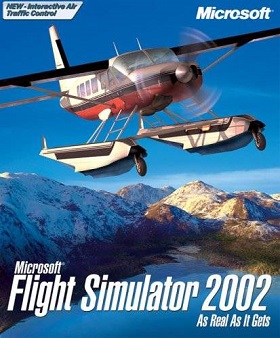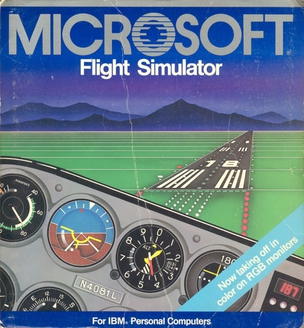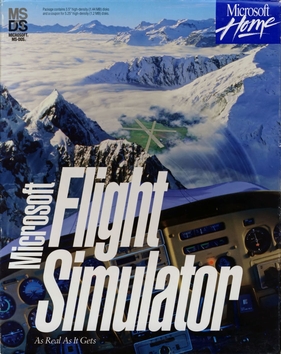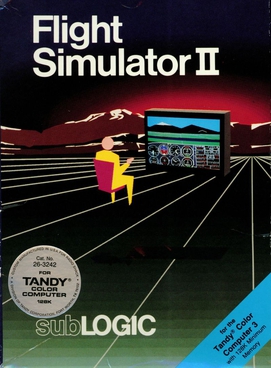
Microsoft Flight Simulator is a series of flight simulator programs for MS-DOS, Classic Mac OS and Microsoft Windows operating systems. It was an early product in the Microsoft application portfolio and differed significantly from Microsoft's other software, which was largely business-oriented. As of November 2022, Microsoft Flight Simulator is the longest-running software product line for Microsoft, predating Windows by three years. Microsoft Flight Simulator is one of the longest-running PC video game series of all time.

Microsoft Flight Simulator 98, abbreviated commonly as FS98, is a flight simulator video game. It was released in September 1997 for Microsoft Windows.

Microsoft Flight Simulator 2002 also known as FS2002, is a video game released in October 2001, and is the 8th installment of the Microsoft Flight Simulator video game series. A version called Professional Edition was released at the same time as standard edition that added two aircraft, a flight instructor feature, and an editor to create buildings and aircraft.

Microsoft Space Simulator is a space flight simulator program, based on Microsoft Flight Simulator for MS-DOS. It was one of the first general-purpose space flight simulators and it incorporated concepts from astrodynamics, motion, and celestial mechanics. Microsoft Space Simulator is a space flight simulator program that was developed by Microsoft and released in 1994. The program allows users to experience the thrill of space flight, while also providing a realistic simulation of the physics and mechanics of space travel.
Sublogic Corporation is an American software development company. It was formed in 1977 by Bruce Artwick, and incorporated in 1978 by Artwick's partner Stu Moment as Sublogic Communications Corporation. Sublogic is best known as the creator of the Flight Simulator series, later known as Microsoft Flight Simulator, but it also created other video games such as Night Mission Pinball, Football, and Adventure on a Boat; educational software; and an Apple II graphics library.
Microsoft Flight Simulator began as a set of articles on computer graphics, written by Bruce Artwick throughout 1976, about flight simulation using 3-D graphics. When the editor of the magazine told Artwick that subscribers were interested in purchasing such a program, Artwick founded Sublogic Corporation to commercialize his ideas. At first the new company sold flight simulators through mail order, but that changed in January 1979 with the release of Flight Simulator (FS) for the Apple II. They soon followed this up with versions for other systems and from there it evolved into a long-running series of computer flight simulators.

Microsoft Flight Simulator X is a 2006 flight simulation video game originally developed by Aces Game Studio and published by Microsoft Game Studios for Microsoft Windows. It is the sequel to Microsoft Flight Simulator 2004 and the tenth installment of the Microsoft Flight Simulator series, which was first released in 1982. It is built on an upgraded graphics rendering engine, showcasing DirectX 10 features in Windows Vista and was marketed by Microsoft as the most important technological milestone in the series at the time. FSX is the first version in the series to be released on DVD media.

Microsoft Flight Simulator 2000, abbreviated commonly as FS2000, is a flight simulator video game. It was released in late 1999 for Microsoft Windows. A Professional Edition was released alongside the standard edition. It added two airplanes, six cities, and a flight model/instrument panel editor.
Bruce Arthur Artwick is an American software engineer. He is the creator of the first consumer flight simulator software. He founded Sublogic after graduating from the University of Illinois at Urbana–Champaign in 1977, and released the first version of Flight Simulator for the Apple II in 1979. His original Apple II software was purchased by Microsoft in 1982 and became Microsoft Flight Simulator 1.0.

Microsoft Flight Simulator for Windows 95, abbreviated commonly as FS95, is a flight simulator video game. It was released in late 1996 for Windows.

Microsoft Flight Simulator, commonly known as Microsoft Flight Simulator 1.0, is a flight simulator video game, released in November 1982 for the IBM PC. It is the first release in the Microsoft Flight Simulator series.

Microsoft Flight Simulator, commonly known as Microsoft Flight Simulator 2.0 or FS2, is a flight simulator video game. It was released in 1984 for the IBM PC as a self-booting disk.

Microsoft Flight Simulator, commonly known as Microsoft Flight Simulator 3.0 or FS3, is a flight simulator video game. It was released in mid-1988 for the MS-DOS.

Microsoft Flight Simulator, commonly known as Microsoft Flight Simulator 5.0 or FS5, is a flight simulator video game. It was released in late 1993 for the MS-DOS. A port for PC-98 was released in 1994. It was the last game in the series for DOS and the last game to appear on a non-Microsoft platform. An updated version, 5.1, was released in 1995. In November 1995, Microsoft acquired the Bruce Artwick Organization (BAO) from Bruce Artwick. Employees were moved to Redmond, Washington, and development of the series continued in-house at Microsoft.
Aces Game Studio (ACES) was an American video game developer based in Redmond, Washington, owned by Microsoft Game Studios. It was founded in 1988 under the name Bruce Artwick Organization Limited at Champaign, Illinois, by Bruce Artwick, creator of Microsoft Flight Simulator, Microsoft Space Simulator and also co-founder of Sublogic.

Jet is a combat flight simulator video game originally published in 1985 by Sublogic. The game was released in 1985 for MS-DOS and the Commodore 64, 1986 for the Apple II, 1988 for the Atari ST and Amiga, and 1989 for the Macintosh and NEC PC-9801.

FS1 Flight Simulator is a 1979 video game published by Sublogic for the Apple II. A TRS-80 version followed in 1980. FS1 Flight Simulator is a flight simulator in the cockpit of a slightly modernized Sopwith Camel. FS1 is the first in a line of simulations from Sublogic which, beginning in 1982, were also sold by Microsoft as Microsoft Flight Simulator.

Flight Simulator II is a video game developed by Bruce Artwick and published by Sublogic as the sequel to FS1 Flight Simulator. It was released in December 1983 for the Apple II, in 1984 for Atari 8-bit and Commodore 64, in 1986 for the Amiga and Atari ST, the Atari XEGS as a pack-in title in 1987 and in August 1988 for the Color Computer 3.

Microsoft Flight Simulator is a 1986 video game developed by Sublogic and published by Microsoft for the Macintosh.
Airfight is an early 3D graphics-based multi-user flight simulator, created on the University of Illinois Urbana-Champaign (UIUC) Control Data Corporation (CDC) PLATO system in the early 1970s.















